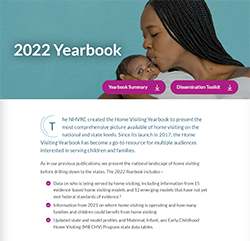Resource | Report | Summary
2022 Home Visiting Yearbook
Project: National Home Visiting Resource CenterThe 2022 Home Visiting Yearbook compiles key data on early childhood home visiting, a proven service delivery strategy that helps children and families thrive. It features updated information from robust data sources, including 15 evidence-based and 12 emerging models.
 Key takeaways include—
Key takeaways include—
- Evidence-based home visiting was implemented in all 50 states, the District of Columbia, 5 territories, 22 tribal communities, and 54 percent of U.S. counties in 2021.
- More than 277,000 families received evidence-based home visiting services in 2021, over the course of more than 3 million home visits. Approximately two-thirds of those home visits were provided virtually.
- Nearly 44,000 additional families received home visiting services through 12 emerging models that provided more than 606,000 home visits in 2021. Nearly three-quarters of these visits were provided virtually.
- More than 21,000 home visitors and supervisors delivered evidence-based services nationwide in 2021.
- Of the more than 17.5 million pregnant women and families (including nearly 23 million children) who could benefit from home visiting, nearly 280,000 received services in 2021. This translates to 1.6 percent of potential beneficiaries, and 3.3 percent of high-priority families based on priority criteria.
- In 2021, the federal Maternal, Infant, and Early Childhood Home Visiting (MIECHV) Program began distributing funds from the American Rescue Plan Act to help home visiting programs continue and expand services, meet families’ basic needs, address the well-being of their workforce, and more.
- In 2021, MIECHV helped fund services for more than 71,000 families in states, the District of Columbia, territories, and tribal communities—a portion of the total families served by home visiting that year.
- States continue to support home visiting by combining funds from tobacco settlements and taxes, lotteries, and budget line items.
The Yearbook includes virtual and in-person home visit data from 2021 to reflect the field’s flexible response to the ever-changing COVID-19 pandemic See the publication’s Statement on COVID-19 for more information, and read the full Yearbook online.
2022 Yearbook
